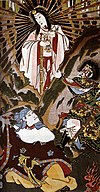| Gaoshi Shrine | |
|---|---|
高士神社 | |
 | |
| Religion | |
| Affiliation | Original: Shinto Current: None |
| Deity | |
| Location | |
| Location | Mudan, Pingtung |
| Country | Taiwan |
| Geographic coordinates | 22°07′21″N 120°50′20″E / 22.12250°N 120.83889°E |
| Architecture | |
| Date established |
|
| Materials | Hinoki wood and concrete |
Gaoshi Shrine (Chinese: 高士神社; pinyin: Gāoshì Shénshè), formerly known as Kuskus Shrine (クスクス祠, Kusukusu Jinjya), is a Shinto shrine located in Gaoshi, a Paiwan village in Mudan, Pingtung, Taiwan. With the original shrine destroyed by typhoon in 1946, a new shrine was rebuilt in 2015, making it the first Shinto shrine constructed in Taiwan in the post–World War II era, following the end of the island's Japanese rule.[3][4] The current shrine is not affiliated with the Shinto religion (or any other deity) but serves as a memorial for the Taiwanese population lost in wars such as World War II.[5]
History
[edit]The shrine was originally built in 1939 during the Japanese rule of Taiwan, but was destroyed in 1946 due to typhoon damage.[1][2] The village's residents wished to rebuild the shrine but could not, as reconstruction was prohibited under martial law at the time. The only surviving portion of the shrine was its concrete base.[3]
In 2015, a kannushi named Ken'ichi Satō (佐藤健一) learned of the shrine's existence through the Friends of Lee Teng-Hui Association (台灣李登輝之友會總會) in Japan, a cultural exchange organization based in Tokyo.[6] Satō decided to rebuild the shrine as a token of appreciation for Taiwan's foreign aid in the 2011 Tōhoku earthquake. The shrine cost JP¥10,000,000 to build.[3]
An opening ceremony was held on 11–12 August 2015 to celebrate the shrine's completion. It involved a Shinto ceremony conducted by Satō, traditional Paiwan dances, and a prayer led by the local pastor, since the majority of Gaoshi's population is Christian.[5]
Structure
[edit]
No records of the original structure exist. The rebuilt shrine is made of hinoki wood, while the roof is covered in copper.[5] In 2016, a white torii, also made of hinoki, was added in front of the shrine.[7][8]
See also
[edit]References
[edit]- ^ a b 蔡宗憲 (6 May 2018). "高士神社首位台籍神官 黃俊瑜主持例祭". Liberty Times (in Chinese (Taiwan)). Retrieved 18 May 2020.
- ^ a b 郭シセン (7 May 2018). "初の台湾人神職が例祭執り行う 「夢への第一歩」に喜び" (in Japanese). Central News Agency. Retrieved 18 May 2020.
- ^ a b c "台版「靖國神社」 明牡丹鄉揭幕". Apple Daily (in Chinese (Taiwan)). 10 August 2015. Retrieved 18 May 2020.
- ^ 劉建邦; 程啟峰 (14 September 2019). "陸男網路稱來台毀損高士神社 移民署:未入境" (in Chinese (Taiwan)). Central News Agency. Retrieved 18 May 2020.
- ^ a b c 蔡宗憲 (11 August 2015). "祖靈祈福加日本儀式 高士佛神社揭幕". Liberty Times (in Chinese (Taiwan)). Retrieved 18 May 2020.
- ^ "Home". ritouki.jp.
- ^ 張茂森 (12 April 2016). "日人捐贈屏東高士神社大鳥居 5/7豎立". Liberty Times (in Chinese (Taiwan)). Retrieved 18 May 2020.
- ^ 葉亭儀 (19 October 2017). "想看絕美鳥居,不必大老遠飛日本!全台7處仙境大公開,靠海純白鳥居實在太夢幻啦". The Storm Media (in Chinese (Taiwan)). Retrieved 18 May 2020.
